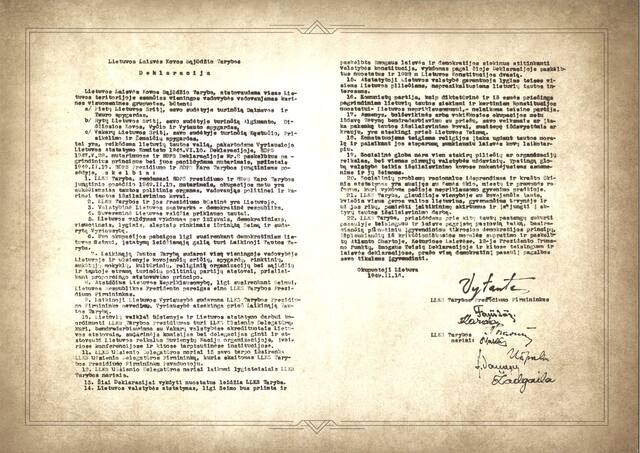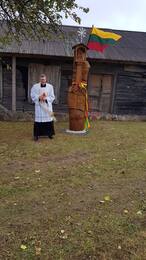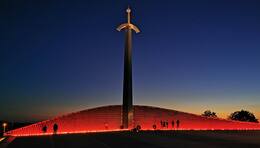Declaration of the Council of the Lithuanian Freedom Struggle Movement
III National Partizans
The Declaration of the Lithuanian Freedom Struggle Movement (LLKS Declaration) is the most important document of the Congress of Lithuanian Partisan Commanders, which was adopted on February 16, 1949.
The Declaration set out the program of anti-Soviet resistance, and the Council of the Lithuanian Freedom Struggle Movement was announced. The Declaration discussed the democratic structure of the restored Lithuanian state and other important issues of the time. The independent Republic of Lithuania was to be restored based on the principles set out in the Declaration and the 1922 Constitution.
The declaration was signed by the following partisan commanders: P. Bartkus - Žadgaila, A. Grybinas - Faustas, L. Grigonis - Užpalis, V. Gužas - Kardas, B. Liesys - Naktis, A. Ramanauskas - Vanagas, J. Šibaila - Merainis and J. Žemaitis Vytautas. All of the signatories of the declaration were killed.
In 1999, the Seimas of the Republic of Lithuania adopted a law recognizing the Declaration of the Lithuanian League of Nations as a legal act of the Lithuanian state. The Declaration was included in the Lithuanian National Register of the UNESCO Memory of the World Programme.
More information sources
Related timeline
Related objects
Sąjūdis Memorial to Lithuanian Freedom Fighters in Minaičiai (Minaičiai Bunker-Museum)
In the autumn of 1948, the farm of partisan supporters A. and S. Mikniai in the village of Minaičiai (Radviliškis district) was chosen as the wintering place for the Prisikėlimo Military District headquarters. The partisans dug a small bunker under the barn to house the staff of the district.
On 16 February 1949, the partisan commanders in Minaičiai finalised and published the declaration of the Lithuanian freedom struggle “Sąjūdis”. The main aim of the Declaration was to restore Lithuania to a parliamentary republic (as it was from 1920–1926). Eight people formally attended the meetings: Jonas Žemaitis- Vytautas, Juozas Šibaila-Merainis, Petras Bartkus-Žadgaila, Adolfas Ramanauskas-Vanagas, Aleksandras Gribinas-Faustas, Vytautas Gužas-Kardas, Leonardas Grigonis-Užpalis, and Bronius Liesys-Naktis.
The bunker was also used later. A partisan pharmacist Izabelė Vilimaitė-Stirna treated partisan Laurynas Mingilas-Džiugas, who was seriously wounded in the Battle of Užpelkiai. In 1953, the unoccupied bunker caved in and the owners earth-filled it.
In 2010, the work on the restoration of the partisan bunker and barn, as well as the construction of the monument began. The monument, created by sculptor Jonas Jagėla, bears the names of the partisans who signed the Declaration. An authentic, glassroofed partisan bunker has been built in the barn, and the visitors are provided an opportunity to see it from above; there is also an exhibition in the barn.
Partisan liaison officer's homestead in Saiai
The homestead of the partisan supporters of the Sajės in Balandiškis, Grinkiškis eldership, Radviliškis district, is connected with the struggles for freedom in Lithuania. Its history is usually presented together with the Mikniai homestead, located in nearby Minaičiai (Lithuanian Freedom Movement Memorial).
This secluded and modest homestead, according to the recollections of Viktoras Šniuolis-Vitvytis, an eyewitness to the events, and confirmed by some research, was the place where the founding documents of the Lithuanian Freedom Struggle Movement (LLKS) were probably prepared. The LLKS became the most important organization of resistance to the Soviet occupation, covering the entire territory of Lithuania. It is reported that since 1946, freedom fighters had been visiting this homestead to rest and get some strength. After the partisan liaisons held a congress of partisan commanders at the Mikniai homestead in February 1949, the headquarters of the LLKS Public Division operated in the Sajai homestead (in a bunker installed in a barn), and the LLKS periodical, the newspaper "Prie rymancių rūpintojėlio", was published.
Partisans visited the bunker of the Sajai homestead many times, wintered there, or were treated for injuries. The hearth of freedom existed in the Sajai homestead until 1952. In the autumn of that year, the bunker was discovered, and the owners of the homestead were arrested.
Currently, the homestead is almost completely dilapidated, but it contains a monument, an information stand, and a chapel pillar to commemorate important historical events that took place at this location.
Monument to the partisans of the Resurrection District in Šeduva
On October 14, a monument to the partisans of the Resurrection District was unveiled in Šeduva Laisvės Square. The authors of the monument: sculptor Romanas Kazlauskas, architects Arūnas Eduardas Paslaitis and Viktorija Paslaitytė. It is a joint work of the Lithuanian Genocide and Resistance Research Center (LGGRTC) and the Radviliškis District Municipality.
Monument to the Partisans of the Resurrection District, commemorating all Lithuanian partisans who fought and died in this district in 1944-1953.
This is another monument dedicated to the memory of the Lithuanian partisan districts. The following districts have already been immortalized: Algimantas – Troškūnai, Anykščiai district, Didžioji Kova – Gelvonai, Širvintos district, Tauras – Marijampolė, Žemaičiai – Telšiai and Vytis – Vadokliai, Panevėžys district.
Lietuvos partizanų memorialas Kryžkalnyje
Memorialas įkurtas Kryžkalnyje, šalia svarbių kelių susikirtimo. Didžiulis, memorialą žymintis kalavijo formos obeliskas, yra gerai matomas važiuojant autostrada Klaipėda-Vilnius ties Kryžkalniu.
Partizanų memorialas yra skirtas pagerbti Lietuvos partizanams, kurie pokario laikotarpiu kovojo prieš sovietinę okupaciją siekdami nepriklausomos Lietuvos. Tai viena didžiausių Lietuvoje vietų, įprasminančių partizanų pasiaukojimą ir atminimą.
Memorialas, sukurtas skulptoriaus Tado Gutausko ir architekto Sauliaus Pamerneckio, buvo atidarytas 2020 m. rugsėjo 20 d. Jis primena ne tik praeities aukas, bet ir kviečia lankytojus prisiminti laisvės kainą bei didžiuotis savo šalies istorija.
Memorialą sudaro trys dalys: 25 metrų aukščio kalavijo formos obeliskas, kuris simbolizuoja partizanų stiprybę ir kovos dvasią, taip pat atminimo siena, kurioje iškalti apie 20000 žuvusių partizanų vardai, išdėstyti Vyties kryžiaus formos stelose bei Pagerbimo aikštė su nežinomo partizano kapu, kuris simbolizuoja visus nežinomus ir neužrašytus, tačiau už Lietuvą paaukojusius savo gyvybes.
Related stories
A fateful meeting in a bunker: the 1949 Congress of Lithuanian Partisan Commanders
On February 10-20, 1949, the only congress of partisan commanders in occupied Lithuania took place in the Mikniai farmstead bunker in the Minaičiai village of Radviliškis district, during which the Lithuanian Freedom Struggle Movement (LLKS) was founded and the Declaration of Independence was proclaimed.
The Last Battle in the Swamp Forest
On August 13, 1949, a fateful battle took place in Radviliškis County, in the Užpelkės Forest, during which Bronius Liesys-Naktis, a member of the Presidium of the Council of the Lithuanian Red Army and a signatory of the February 16 Declaration, was killed, along with other partisans of the Prisikėlimų district.








